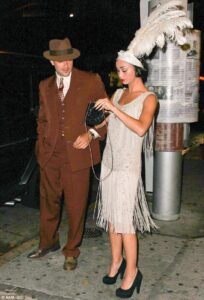In the 1920s Fashion, underwent a dramatic transformation, reflecting the cultural shifts and societal changes of the era. The iconic flapper style emerged, characterized by its daring and rebellious spirit, with women embracing shorter hemlines, boyish silhouettes, and bobbed haircuts. This departure from the restrictive fashions of the past symbolized newfound freedom and independence for women. Men’s fashion also saw evolution, with classic suits and evening wear maintaining their timeless appeal, while casual attire embraced sweaters and sportswear influenced by Hollywood icons. Fabrics like silk, velvet, and chiffon were popular choices, often embellished with intricate beadwork and Art Deco motifs. Accessories such as cloche hats, Art Deco jewelry, and stylish handbags completed the look, Abstract of the glamour and eagerness of the Roaring Twenties.
TABLE CONTENT
- Men’s Fashion
- Women’s Fashion
- Fabrics and Textiles
- Accessories and Accoutrements
- Key Figures and Influence
- Legacy of 1890s Fashion

1920s-fashion
Men’s Fashion in the 1920’s
Classic Suits and Evening Wear
Men’s fashion in the 1920s retained a sense of timeless elegance with classic suits and formal evening wear. Suits featured a relaxed fit with straight-leg trousers and single-breasted jackets, often paired with vests for a polished look. Evening wear included tuxedos or dinner jackets for formal occasions, maintaining a sense of sophistication and refinement.
Casual Attire, Sweaters and Sportswear
The 1920s saw the rise of more casual attire for men, influenced by the growing popularity of sports and leisure activities. Sweaters, often made of wool or knitted fabric, became fashionable for casual wear, providing warmth and comfort. Sportswear, such as tennis sweaters and golfing attire, reflected the relaxed lifestyle of the era and embraced a more casual aesthetic.
Influence of Hollywood Icons
The growing influence of Hollywood celebrities and leading men further shaped men’s fashion in the 1920s. Actors like Rudolph Valentino and Douglas Fairbanks set trends with their on-screen personas, popularizing styles such as the wide-brimmed fedora and the double-breasted suit. Hollywood’s glamorous image and aspirational lifestyle influenced the way men dressed, with a focus on suave and debonair looks. The influence of Hollywood icons extended beyond clothing to grooming trends, with slicked-back hair and carefully manicured appearances becoming fashionable among men seeking to emulate the silver screen stars of the era.
Women’s Fashion in the 1920’s
Flapper Style Iconic Characteristics
The 1920s is synonymous with the iconic flapper style, characterized by its daring and liberated look. Flapper dresses featured dropped waists, loose silhouettes, and shorter hemlines, reflecting the newfound freedom and independence of women. These dresses were often embellished with beading, fringe, and Art Deco motifs, adding glamour and sophistication to the flapper aesthetic.
Shift from Corsets to Freedom
The 1920s marked a significant shift away from the restrictive fashions of the past, as women abandoned corsets in favor of more comfortable and practical clothing. The rejection of corsets allowed for greater freedom of movement and paved the way for the relaxed and boyish silhouettes of flapper fashion. Women embraced a more casual and liberated approach to dressing, reflecting changing social attitudes and the desire for greater equality.
Rise of Hemlines and Bobbed Hair
One of the most distinctive features of 1920s fashion was the rise of hemlines, with skirts and dresses becoming increasingly shorter and more revealing. This shift towards shorter hemlines was accompanied by the popularity of bobbed haircuts, which symbolized modernity and youthfulness. Together, these trends represented a radical departure from traditional notions of femininity, ushering in a new era of modernity and experimentation in women’s fashion.
Overview of Fabrics and Textiles in 1920s Fashion
Luxurious Fabrics for Evening Wear
-
- Evening wear in the 1920s was characterized by the use of luxurious fabrics such as silk, satin, and velvet.
- These fabrics were favored for their opulent texture and lustrous appearance, adding a sense of glamour and sophistication to evening dresses and gowns.
Embellishments and Art Deco Motifs
-
- Fabrics in 1920s fashion were often embellished with intricate beadwork, sequins, and embroidery, reflecting the influence of the Art Deco movement.
- Art Deco motifs, characterized by geometric patterns and bold designs, were popular embellishments on dresses, adding a touch of modernity and elegance to the garments.
Accessories and Accoutrements of 1920s Fashion
Cloche Hats
Women adorned their heads with stylish cloche hats, which hugged the head closely and featured a rounded crown. These hats added a touch of sophistication to outfits and framed the face beautifully, reflecting the modern and chic style of the era.
Art Deco Jewelry
Women accessorized their ensembles with dazzling Art Deco jewelry, featuring geometric shapes, bold colors, and intricate designs. These statement pieces added glamour and elegance to outfits. Also showcasing the craftsmanship and artistic flair of the period.
Beaded Handbags
Beaded handbags were a popular accessory for women in the 1920s, offering both style and practicality. These handbags were often embellished with intricate beadwork and delicate patterns, providing a glamorous touch to evening ensembles and adding a sense of luxury to everyday outfits.
T-Strap Shoes
T-strap shoes became fashionable footwear for women in the 1920s, featuring a strap that crossed over the instep in the shape of a “T”. These shoes were comfortable and versatile, suitable for dancing the night away at jazz clubs or strolling through city streets in style.
Feather Boas
Feather boas were a playful and flamboyant accessory worn by women to add drama and flair to their outfits. These soft and fluffy accessories draped elegantly around the neck and shoulders, creating a sense of movement and allure as they caught the light and swayed with every step.